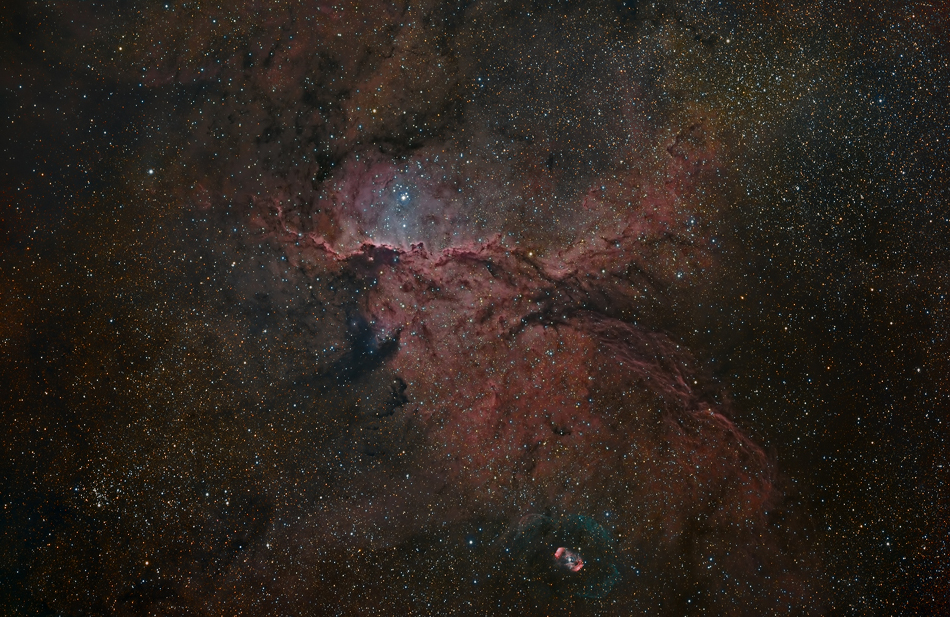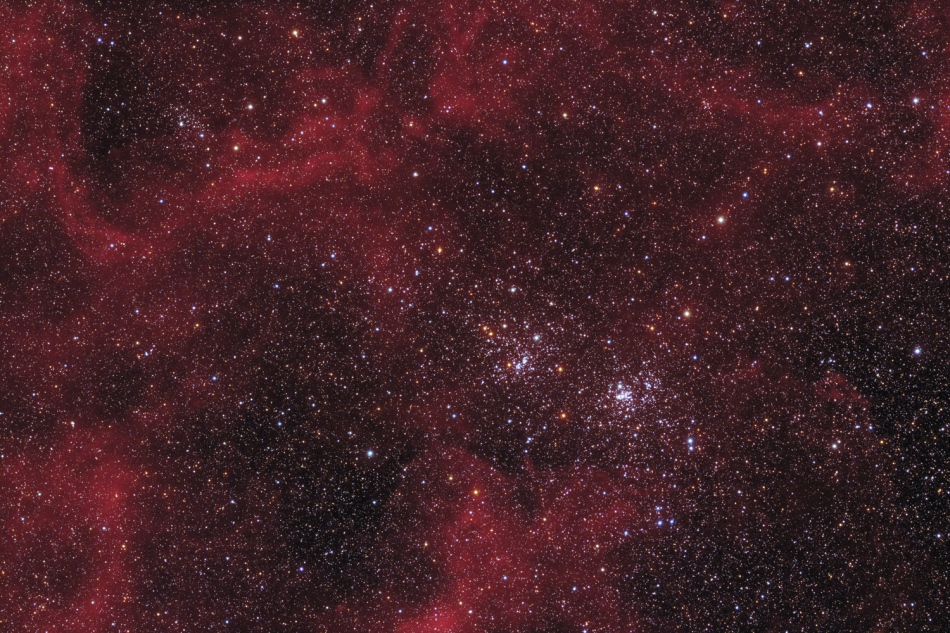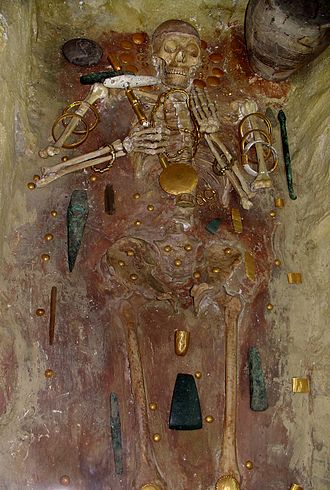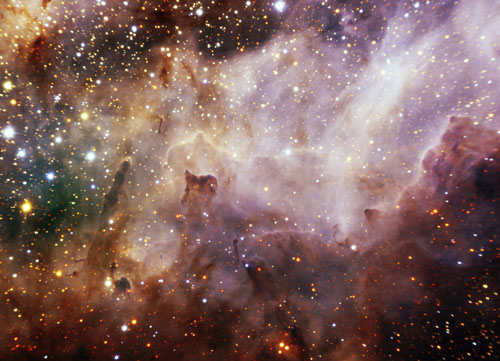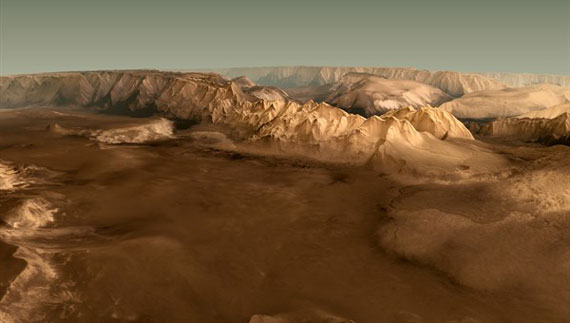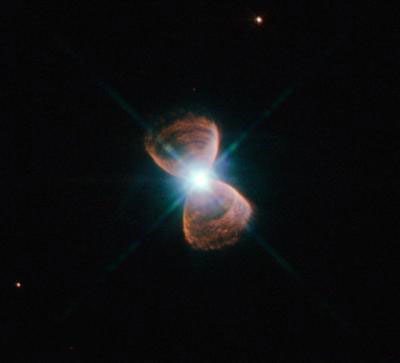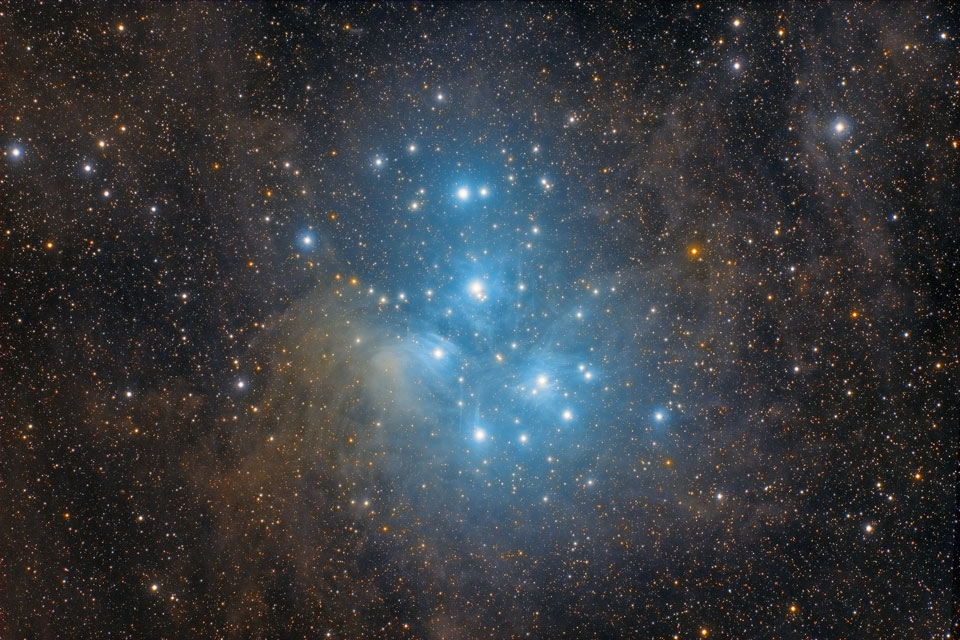Image Credit & Copyright: Harel Boren and Tal Faibish

Friday, January 31, 2014
Wednesday, January 29, 2014
astro picture for the day
Image Credit & Copyright: Fabian Neyer
- youtube extra, DreamChaser spaceplane,
SpaceX has been ahead and should remain there for awhile, but there's others with great innovations to make space happen. Blue Origins I find kind of similar to SpaceX. DreamChaser has a novel technology here that can work with SpaceX actually. There's others with great engine innovations; I forget who, buy they've found that piston pumped rocket engines instead of turbo can make for greater reliability and cost reductions. Now, if SpaceX and these others could get that technology. And, there's other even more radical technologies; a kind of scramjet/rocket engine hybrid using superconducting is being innovated in England; but, they're at least a decade away. Well, enjoy the DreamChaser video!
- Science/Tech extra,
nanotechnologists have used nanotubes to make a nanocomputer smaller than a single biological cell.
nanotube computer self assembled from the bottom up . What's interesting about this is they can design any number of different computers with this technology; and they chose to design their first nanocomputer to be able to control actuators and sensors. What actuators? Some kind of nano-actuators to manipulate and position individual atoms? So far, the major science/technology blogs I know of have chosen not to mention or comment about this; sorry to sound conspiracy like, but 'do they want to keep this quiet for some reason?'
The New Horizons spacecraft to Pluto(and hopefully Sedna) group has made this cute video,
Thursday, January 23, 2014
youtube for the day/ Robert Johnson documentary/belief in the devil in a society
This outstanding documentary of Robert Johnson reveals much. It shows, be means of people playing live, how great is the Delta blues and Robert Johnson music. I know from the beginning of my own efforts almost two decades ago now, and hearing what others things of it, that people often feel Robert Johnson for one is a bit Spartan sound. Sounds like dirt on a dirt road. Sometimes, one has to see these things live to really see and hear it and feel it.
I've heard of John Hammon before, but I didn't believe he could play. But, to some topics that comes up in the movie that I found a bit striking . . .
. . . the people Mr Hammond was able to find(and he finds some interesting ones!) seemed almost embarrassed to talk about Robert Johnson. His death by poisoning seems pretty clear, so the embarrassment is a bit over-worrisome imo; but, the interesting issue that comes up when discussing the blues and Robert Johnson back then for these people is that the music is devil worship. They say a bluesmen must have sold his soul to the devil to learn how to play like that. And indeed, Robert Johnson and other bluesmen(I can think of Peetie Wheatstaw who also liked to associate himself with devil and the blues) almost wanted to be associated with this folklore of selling your soul to the Devil to learn the blues. Robert Johnson wanted to learn the blues so bad so he can 1) stay off the plantation, and 2) get lots of women. It ultimately cost him his life of course.
Wednesday, January 22, 2014
astro picture for the day/Quote for the day extra
ESO/Very Large Telescope image
A zoomable view of the Lagoon nebula . I find that just two or three clicks to the right is good enough.
Quote for the day
"Life is only a short episode between two eternities of death, and even in this episode, conscious thought has lasted and will last only a moment. Thought is only a gleam in the midst of a long night. But the gleam is everything." - Henri Poincare
- ScienceTech news extra 27Jan2-14 edit,
Nanowire nanocomputer built , it's kind of striking they design the computer for controlling nano-actuators; actuators to control what? Atom by atom assembly?
Tuesday, January 21, 2014
astro picture for the day
NASA, ESA, and the Hubble Heritage Team (STScI/AURA)
Acknowledgement: William Blair (Johns Hopkins University)
Wednesday, January 15, 2014
youtube for the day/ Flatland the movie!
I didn't think I'd ever see this again. This is just a funny video from one of many teams that compete with one another in the early days of dna-nanotech.
This post was originaly just a great funny video from a dna-nanotech team I like. I decided to make this post kind of an all around science/tech videos, with maybe Flatland being the main attraction.
Flatland is one book I haven't quite gotten around to reading. I'm hearing this animation video does make a few changes here and there; but, overall, this is a pretty good video of higher and lower dimensions started by Edwin Abbott Abbott. Ope, just googled, and found there's another Flatland movie out. Well, this is the one on youtube.
Couple of things I thought that could make for interesting generalisations beyond Flatland as presented here is color mapping and Euclid's proof of the Pythagorean theorem. This flatland movie has a conflict between those irregulars that choose to be colorful, and the regulars triangles, squares, circles and lines(which are generally females). Color mapping could have proven useful. And Euclid's proof of Pythagorean theorem leads to ways of decomposing triangles into squares, or rectangles. David Hilbert's "Foundation of Geometry" gets into this decomposing a lot more.
One thing I noticed in this movie is how triangles and squares were talking to each other asymmetrically. The mouth of the square would be at the bottom where it's generally suppose to be while the triangles mouth is up top. They could have shown how going through the third dimension, either the square or the triangle could be flipped over so they can talk to each other straight and not upside down to one another, but they don't seem to be cognizant of this.
The movie gets into class warfare and rascisms. In terms of scientific humanism, there's idealization and generalization. In mathematics, concepts are fine tuned so that they are not over/under generalized. Idealisations are made to make sense, or logical. Idealisations that don't make sense are disproved. Rascisms are idealisations that don't make sense - like color dictates a person's reasoning ability. Of course, this flatland movie doesn't suggest this type of philosophy.
astro video for the day/ more Mars flyby videos!
There's a previous mars flyby video posted on Monday, Jan 13, 2014, 4:17 P.M. on my blog.
- Science extra,
BOSS measures the universe to one percent accuracy
Or, at least, BOSS measures the distances to galaxies six billion lights years out to one percent accuracy. “Twenty years ago astronomers were arguing about estimates that differed by up to fifty percent. Five years ago, we’d refined that uncertainty to five percent; a year ago it was two percent. One-percent accuracy will be the standard for a long time to come.” . . . the Inflationary generalization of the Big Bang universe theory predicts the universe is extremely flat; the BOSS measurements supports this to a high degree.
Astronomer's have plans to go far beyond BOSS; "The proposed Dark Energy Spectroscopic Instrument (DESI), based on an international partnership of nearly 50 institutions led by Berkeley Lab, would enable the Mayall Telescope on Kitt Peak in Arizona to map over 20 million galaxies, plus over three million quasars, in 14,000 square degrees of the northern sky. By filling in the missing eons that BOSS can’t reach, DESI could sharpen and extend coverage of the expansion history of the universe from the first appearance of the cosmic background radiation to the present day."
Tuesday, January 14, 2014
thought for the day/Mankind's discovery of the Element/Atoms
29Jan2014 edit, Copper Bull from Temple of Ninhursag, Tell al-'Ubaid, in contemporary southern Iraq.
As I say at the top, I've placed this Bull made of copper on this post long after originaly making this post. It should be placed a bit lower in the post somewhere. But, since I'd probably have to rewright everything below, I'm just placing this on top. The article is about mankinds discovery of various elements and ultimately atoms(I never get into the relationship between elements and atoms as discovered in the early 1800s actually!). Copper is amongst the very first, certainly before iron. The copper bull above is stunning for other reasons - Mythological reasons. If you read through my blog, you'll see mention and references to the ubiquitessness of bulls in ancient societies mythology. For instance, the old testament, Moses is made to destroy a golden bull. There's a a great bull from Minoa, Crete. So, here we have a bull made of one of the first artificial materials discovered by mankind!
Homo Erectus appears to be the first and still only lifeform on Earth that learned anything about fire and used it. I've written some stuff about fire usage a little ways back. The first evidences for this appears to be in China. The caves date back like four hundred thousand years ago. One wonders why it took so long for human culure to go from this first fire usage to, say, industrialism. Well, if the dark ages, well documented today, says anything, it's that cultures have trouble maintaining themselves. Another problem was a series of ice ages. There's been some little ice ages, but for the most part, the cultures that led to us and the Cave painters arise from the last major ice age ten thousand years ago. A quick wiki look shows that today's Geologists consider us in an ice age that started 2.5 million years ago, called the Pliocene-Quaternary ice age. It's in that little time compared to geologic(and really astronomical) time, that humanity found that fire can create metals.
Backtracking a little bit, there's some controversy on whether the first fire users made fire by some technological means, like rubbing wood together; or, did they just take some fire from a tree recently struck by lightning? They'd then have to keep it going. In language, there's the idea of the hearth, a place where a fire is kept going. However they discovered how to make and use fire, our ancestors much later found they could create metals out of fire.
As of 2014, Archaeologists find that the first metals go back to Varna, Bolgeria. This is up around current Turkey. There, the first evidence of Gold is found - around 4,750 B.C. So that's pretty close to six thousand years ago.
-Here's probably the most famous picture from Varna showing someone buried with gold all around.
Anthropologists and archeaologists generaly define the major human periods by what materials is just discovered. So before the copper/bronze age, there's the Stone age back to four, five million years ago. The copper/bronze age is of course approximately around five thousand B.C.
While the only metals possible before the Iron age was copper/bronze, they did make use of the the iron of meteorites. It's noted that the ancients couldn't make iron, but they could get it from meteorites, and they would gather all the meteorites around them; consequently, today, in places like the middle east, Egypt, you can't find meteorites!(or, at least, it's a lot harder) Meteorites are mentiond in the Epic of Gilgamesh.
"his strength is as mighty as the meteorite of anu". The Epic of Gilgamesh also mentioned copper and bronze locks and other stuff. I can't help noting more things about the Epic of Gilgamesh. Gilgamesh is out for adventure; but, this adventure is more about traveling off to distant lands for knowledge. It's not a mathematical adventure. There's lots of mention of Bulls in heaven. And when he tries to cross the sea, the sea is defined as twelve stages(twelve constellations of the Zodiac?). The Shemesh temple is the setting sun(I've posted plenty about the ideas that Jesus Christ is a Sun god, with twelve followers which are just personifications of the twelve constellations). Tablet XI has the famous flood story.
In the Judean flood story, the flood is about destroying anybody who doesn't take on Gods covenant. The Jews are famous for inventing the one god; conveniently, according to them, there's only one god, and you can only follow him or else you are banished. This is a very intolerant religion. People think the ancients hated the Jews just because . . . well, nobody knows why; this is why, because they had this intolerant one god religion. The Jews made a flood story after the Epic of Gilgamesh to say that a flood should happen to wipe away all their enemies; namely, everybody but them. "6:18 But with thee will I establish my covenant; and thou shalt come into the ark, thou, and thy sons, and thy wife, and thy sons' wives with thee." In the Epic of Gilgamesh, even the writers of the Epic of Gilgamesh found the flood story unethical. Gilgamesh is quoted, "But what shall answer the city, the populace, and the elders?" and "How could I say evil things in the assembly of the gods. ordering a catastrophe to destroy my people!" The writers have the gods answer to Gilgamesh, "who just tell them you'll be back in time.
Enough bible bashing, even If I do feel justified in doing so!
Wood fires could only separate copper, gold and silver. So, these were the first metals to be discovered. Backtracking again a little bit; Archaeologists suggest that Varna traded with people as far as Russia. Cypress, a Greek island, perhaps became the major place for copper mining after the Varna culture collapsed for whatever reason. Bronze was a mix of tin and copper. They didn't know tin, they just found tin/copper ores which were rare. The Iron age began sometime around 1000B.C.
Nobody knows for sure who/how the iron age began. One of the major archaeological puzzles is the sea peoples. The Sea peoples came out of nowhere and destroyed the whole world of Troy and others; this started a dark ages from which the Jewish Bible for one evolved out of and the Greeks and then the Romans. The Egyptians were the only culture to be able to fight the Sea people's back. Biblical archaeologists are fascinated by the sea peoples because there seems to be lots of Canaanite destruction; the Bible would have you that Joshua destroyed the walls of Jericho. Well, that myth has been disproved in other ways, but there's still a strange amount of destruction all around that time period. Archaeologists are pretty sure the "Sea People" did it; but, they're not sure who the Sea people were - Minoans maybe? A major civilization of the time that most people never hear about are the Hittites. the Hittites were in competition with the Egyptians way back in this Troy time. Their records mention a city of Troy; but, they call them another name. I'm forgetting the name; starts with W. Anyways, The Hittites self destructed in a mysterious way. Some say a civil war; and maybe that's the case, but that idea doesn't rule out an idea of mine. The Sea peoples were some of those Hittites. The Hittites appear to have first discovered iron. Iron needs higher temperatures. They found higher temperatures by burning charcoal(just burnt wood). Took them a few centuries to make the process reliable; but, maybe those who did went on a rampage . . . . I have a post way back about the Hittites and some twelve gods, and other Hittite gods, and the effort by a Hittite queen to unify them all. It's all engraved in rock up around Turkey(where the Hittites lived).
Speeding through a bunch of history, which I've more or less given some posts about throughout this blog, around 750 A.D. Jabiribn Hayyan discovered a form of pure vinegar called, Ascetic acid. With this acid, one could do chemistry without fire for the first time. But, fire was still useful. Around 1640, coke, a form of pure carbon was discovered. The English would use it a bit later to mass produce iron. The first iron arch bridge was built around 1775.
In 1669, Henning Brand heated urine to find phosphorus. The first element found since Iron, and from a rather interesting sourse. I don't think I know every person and element found(there's 92 natural atoms, or elements), so, I'm going to try to just mention elements discovered with some kind of significance.
Another element mixed in with copper that helped make Bronze stronger than copper was Nickel. Nickel was discovered in 1751. I've already skipped the discoveries of Cobalt and Plotinum.
The word gas was invented by Jan Baptista van Helmont around 1624. He noticed many vapors other than air. In 1766, Henry Cavendish discovered the simplest atom, Hydrogen. He did so by means of gases interacting with acids. Henry Cavendish is famous for weighing the earth and coming up with an experiment to get the data to plug into Newton's equations. It's a string with a horizontal pole hanging at the bottom. The pole has two masses attached. In the dark, with the use of lights, one can exaggerate the gravitational attraction to two masses.
Nitrogen was also discovered by gases in 1772. It involves a famous experiement of Lavoisier and Priestly, where they also discovered Oxygen. They heated water in one flask, and let gas go to another where they'd condence. by measurement, they'd notice a difference of weight - signifying another element. It was noted by these men that clearly, plants take in carbon dioxide and gives off oxygen, and animal life takes in oxygen and gives out carbon dioxide.
In 1794, elements were discovered in "Rare Earths." Earths are oxides unsoluble by water and resistant to the action of heat - these are calcium, magnesium, iron, and silicon oxides - what the Earth's crust is made out of. Then there's rare earths, and these have elements/atoms associated with them.
Skipping a whole bunch of elements discovered . . . in 1807, Humphrey Davey discovered elements by means of electricity and the new batteries. He found Sodium, Potassium, Barium, Strontium, calcium, and magnesium.
In 1825, Orsted, who discovered the electromagnetic relation(moving magnets cause electrons to move, moving electrons make magnetic fields to appear), discovered aluminum. Aluminum is taken for granted today; apparently, it took sixty years for scientists/engineers to mass produce aluminum; it was big scientific news back then.
I don't know what complexities they're talking about, but apparently, through a more detailed analyses of rare earths, more rare earth elements were found in 1839; again, this was big scientific news for the day back then - lanthanium, yttrium, erbium, terbium, didynium.
In 1859, Gustav Robert Kirchhoff used spectrometers to find new elements. In 1868, Pierre-Jules-Cesar Janssen and Joseph Norman Lockyear discovered Helium in the sun's spectrum! We discovered helium in the sun before we found it on the Earth!
In 1869, Dmitry Ivanovich Mendeleyev made a periodic table of the elements. He used this to predict new elements which would later be confirmed by chemists.
In 1895, Rontgen found X-rays; he x-rayed his hand and sent the picture to Henry Poincare of all people,
Becquerel used x-ray experiments to discover radioactivity. He meant to study fluorescence. But, the material he x-rayed couldn't be emitting anything since he wrapped it in paper. Something else must be happening. The elements already there must be emitting something . . . . In 1898, Marie Currie used radioactivity to discover Polonium and Radium
In 1937, Emilos Segre experimentally produced technetium. They used a particle accelerator from Ernest Lawrence(the inventor of the particle accelerators). They knew what element they wanted, they found some radioactive process to make it, and they made it, almost artificially!
The last element of the period table was discovered in 1945 - Promethium.
I had to look back to find this last curious historical fact of mankinds discovering the various distinct atoms. Uranium was discovered back in the 1700s after the William Herschel discovery of . . . you guessed it . . . the planet Uranus.
As I say at the top, I've placed this Bull made of copper on this post long after originaly making this post. It should be placed a bit lower in the post somewhere. But, since I'd probably have to rewright everything below, I'm just placing this on top. The article is about mankinds discovery of various elements and ultimately atoms(I never get into the relationship between elements and atoms as discovered in the early 1800s actually!). Copper is amongst the very first, certainly before iron. The copper bull above is stunning for other reasons - Mythological reasons. If you read through my blog, you'll see mention and references to the ubiquitessness of bulls in ancient societies mythology. For instance, the old testament, Moses is made to destroy a golden bull. There's a a great bull from Minoa, Crete. So, here we have a bull made of one of the first artificial materials discovered by mankind!
Homo Erectus appears to be the first and still only lifeform on Earth that learned anything about fire and used it. I've written some stuff about fire usage a little ways back. The first evidences for this appears to be in China. The caves date back like four hundred thousand years ago. One wonders why it took so long for human culure to go from this first fire usage to, say, industrialism. Well, if the dark ages, well documented today, says anything, it's that cultures have trouble maintaining themselves. Another problem was a series of ice ages. There's been some little ice ages, but for the most part, the cultures that led to us and the Cave painters arise from the last major ice age ten thousand years ago. A quick wiki look shows that today's Geologists consider us in an ice age that started 2.5 million years ago, called the Pliocene-Quaternary ice age. It's in that little time compared to geologic(and really astronomical) time, that humanity found that fire can create metals.
Backtracking a little bit, there's some controversy on whether the first fire users made fire by some technological means, like rubbing wood together; or, did they just take some fire from a tree recently struck by lightning? They'd then have to keep it going. In language, there's the idea of the hearth, a place where a fire is kept going. However they discovered how to make and use fire, our ancestors much later found they could create metals out of fire.
As of 2014, Archaeologists find that the first metals go back to Varna, Bolgeria. This is up around current Turkey. There, the first evidence of Gold is found - around 4,750 B.C. So that's pretty close to six thousand years ago.
-Here's probably the most famous picture from Varna showing someone buried with gold all around.
Anthropologists and archeaologists generaly define the major human periods by what materials is just discovered. So before the copper/bronze age, there's the Stone age back to four, five million years ago. The copper/bronze age is of course approximately around five thousand B.C.
While the only metals possible before the Iron age was copper/bronze, they did make use of the the iron of meteorites. It's noted that the ancients couldn't make iron, but they could get it from meteorites, and they would gather all the meteorites around them; consequently, today, in places like the middle east, Egypt, you can't find meteorites!(or, at least, it's a lot harder) Meteorites are mentiond in the Epic of Gilgamesh.
"his strength is as mighty as the meteorite of anu". The Epic of Gilgamesh also mentioned copper and bronze locks and other stuff. I can't help noting more things about the Epic of Gilgamesh. Gilgamesh is out for adventure; but, this adventure is more about traveling off to distant lands for knowledge. It's not a mathematical adventure. There's lots of mention of Bulls in heaven. And when he tries to cross the sea, the sea is defined as twelve stages(twelve constellations of the Zodiac?). The Shemesh temple is the setting sun(I've posted plenty about the ideas that Jesus Christ is a Sun god, with twelve followers which are just personifications of the twelve constellations). Tablet XI has the famous flood story.
In the Judean flood story, the flood is about destroying anybody who doesn't take on Gods covenant. The Jews are famous for inventing the one god; conveniently, according to them, there's only one god, and you can only follow him or else you are banished. This is a very intolerant religion. People think the ancients hated the Jews just because . . . well, nobody knows why; this is why, because they had this intolerant one god religion. The Jews made a flood story after the Epic of Gilgamesh to say that a flood should happen to wipe away all their enemies; namely, everybody but them. "6:18 But with thee will I establish my covenant; and thou shalt come into the ark, thou, and thy sons, and thy wife, and thy sons' wives with thee." In the Epic of Gilgamesh, even the writers of the Epic of Gilgamesh found the flood story unethical. Gilgamesh is quoted, "But what shall answer the city, the populace, and the elders?" and "How could I say evil things in the assembly of the gods. ordering a catastrophe to destroy my people!" The writers have the gods answer to Gilgamesh, "who just tell them you'll be back in time.
Enough bible bashing, even If I do feel justified in doing so!
Wood fires could only separate copper, gold and silver. So, these were the first metals to be discovered. Backtracking again a little bit; Archaeologists suggest that Varna traded with people as far as Russia. Cypress, a Greek island, perhaps became the major place for copper mining after the Varna culture collapsed for whatever reason. Bronze was a mix of tin and copper. They didn't know tin, they just found tin/copper ores which were rare. The Iron age began sometime around 1000B.C.
Nobody knows for sure who/how the iron age began. One of the major archaeological puzzles is the sea peoples. The Sea peoples came out of nowhere and destroyed the whole world of Troy and others; this started a dark ages from which the Jewish Bible for one evolved out of and the Greeks and then the Romans. The Egyptians were the only culture to be able to fight the Sea people's back. Biblical archaeologists are fascinated by the sea peoples because there seems to be lots of Canaanite destruction; the Bible would have you that Joshua destroyed the walls of Jericho. Well, that myth has been disproved in other ways, but there's still a strange amount of destruction all around that time period. Archaeologists are pretty sure the "Sea People" did it; but, they're not sure who the Sea people were - Minoans maybe? A major civilization of the time that most people never hear about are the Hittites. the Hittites were in competition with the Egyptians way back in this Troy time. Their records mention a city of Troy; but, they call them another name. I'm forgetting the name; starts with W. Anyways, The Hittites self destructed in a mysterious way. Some say a civil war; and maybe that's the case, but that idea doesn't rule out an idea of mine. The Sea peoples were some of those Hittites. The Hittites appear to have first discovered iron. Iron needs higher temperatures. They found higher temperatures by burning charcoal(just burnt wood). Took them a few centuries to make the process reliable; but, maybe those who did went on a rampage . . . . I have a post way back about the Hittites and some twelve gods, and other Hittite gods, and the effort by a Hittite queen to unify them all. It's all engraved in rock up around Turkey(where the Hittites lived).
Speeding through a bunch of history, which I've more or less given some posts about throughout this blog, around 750 A.D. Jabiribn Hayyan discovered a form of pure vinegar called, Ascetic acid. With this acid, one could do chemistry without fire for the first time. But, fire was still useful. Around 1640, coke, a form of pure carbon was discovered. The English would use it a bit later to mass produce iron. The first iron arch bridge was built around 1775.
In 1669, Henning Brand heated urine to find phosphorus. The first element found since Iron, and from a rather interesting sourse. I don't think I know every person and element found(there's 92 natural atoms, or elements), so, I'm going to try to just mention elements discovered with some kind of significance.
Another element mixed in with copper that helped make Bronze stronger than copper was Nickel. Nickel was discovered in 1751. I've already skipped the discoveries of Cobalt and Plotinum.
The word gas was invented by Jan Baptista van Helmont around 1624. He noticed many vapors other than air. In 1766, Henry Cavendish discovered the simplest atom, Hydrogen. He did so by means of gases interacting with acids. Henry Cavendish is famous for weighing the earth and coming up with an experiment to get the data to plug into Newton's equations. It's a string with a horizontal pole hanging at the bottom. The pole has two masses attached. In the dark, with the use of lights, one can exaggerate the gravitational attraction to two masses.
Nitrogen was also discovered by gases in 1772. It involves a famous experiement of Lavoisier and Priestly, where they also discovered Oxygen. They heated water in one flask, and let gas go to another where they'd condence. by measurement, they'd notice a difference of weight - signifying another element. It was noted by these men that clearly, plants take in carbon dioxide and gives off oxygen, and animal life takes in oxygen and gives out carbon dioxide.
In 1794, elements were discovered in "Rare Earths." Earths are oxides unsoluble by water and resistant to the action of heat - these are calcium, magnesium, iron, and silicon oxides - what the Earth's crust is made out of. Then there's rare earths, and these have elements/atoms associated with them.
Skipping a whole bunch of elements discovered . . . in 1807, Humphrey Davey discovered elements by means of electricity and the new batteries. He found Sodium, Potassium, Barium, Strontium, calcium, and magnesium.
In 1825, Orsted, who discovered the electromagnetic relation(moving magnets cause electrons to move, moving electrons make magnetic fields to appear), discovered aluminum. Aluminum is taken for granted today; apparently, it took sixty years for scientists/engineers to mass produce aluminum; it was big scientific news back then.
I don't know what complexities they're talking about, but apparently, through a more detailed analyses of rare earths, more rare earth elements were found in 1839; again, this was big scientific news for the day back then - lanthanium, yttrium, erbium, terbium, didynium.
In 1859, Gustav Robert Kirchhoff used spectrometers to find new elements. In 1868, Pierre-Jules-Cesar Janssen and Joseph Norman Lockyear discovered Helium in the sun's spectrum! We discovered helium in the sun before we found it on the Earth!
In 1869, Dmitry Ivanovich Mendeleyev made a periodic table of the elements. He used this to predict new elements which would later be confirmed by chemists.
In 1895, Rontgen found X-rays; he x-rayed his hand and sent the picture to Henry Poincare of all people,
Becquerel used x-ray experiments to discover radioactivity. He meant to study fluorescence. But, the material he x-rayed couldn't be emitting anything since he wrapped it in paper. Something else must be happening. The elements already there must be emitting something . . . . In 1898, Marie Currie used radioactivity to discover Polonium and Radium
In 1937, Emilos Segre experimentally produced technetium. They used a particle accelerator from Ernest Lawrence(the inventor of the particle accelerators). They knew what element they wanted, they found some radioactive process to make it, and they made it, almost artificially!
The last element of the period table was discovered in 1945 - Promethium.
I had to look back to find this last curious historical fact of mankinds discovering the various distinct atoms. Uranium was discovered back in the 1700s after the William Herschel discovery of . . . you guessed it . . . the planet Uranus.
Monday, January 13, 2014
astro picture for the day
Credit: NASA, ESA, and Z. Levay (STScI/AURA)
- science/technology extra,
The first molecular assembler?
Now, imagine making millions of these things, doing desired chemistry, and depositing the products in specified ways; we could have molecular manufacturing sooner enough!
astro picture for the day
Credit: ESA/Herschel/ Ph. André, V. Könyves, N. Schneider (CEA Saclay, France) for the Gould Belt survey Key Programme
astro picture for the day
ESA/NASA Hubble Space Telescope image
This is a proto-star(at the very center of the brightest part of the image), it hasn't quite ignited or sustained nuclear fusion at its core. We're seeing gas/dust infalling through magnetic fields.
astro picture for the day
The two bright stars are Alpha and Beta Centauri; the circled star is Proxima centuari; this is the closest star system to our own.
Pluto is between almost thirty and fifty a.u.s out. Astronomical distance is the earth/sun distance. The alpha centuari star system is almost three hundred thousand a.u.s out.(it's approximately 271,000 a.u out)
If a mile corresponds to an a.u., then alpha centauri would be the equivalent of a little further than Earth/Moon distance. This is of course just one star(really two star systems).
One could further try to comprehend the size of the galaxy; according to our size standards of a mile equivalent to an a.u. The Milky Way is approximately a hundred thousand light years across, which is 6,320,400,000AUs across. What would be six billion miles out? Pluto gets to seven billion miles away. So the Milky way would be the equivalent of the distance of the earth pluto distance.
If you look at a diagram to scale of our solar system, you can't really find the Earth/Moon distance without really looking. And note, that we're talking about the distance between our solar system and the nearest Star system, Alpha Centauri, not the planets in our solar system.
astro picture for the day
Image Credit: NASA/JHU Applied Physics Lab/Carnegie Inst. Washington
The streaks on one side were the side nobody had ever seen till the recent Mercury space probe.
The false color shows new prominent features; around 7 seconds in the north side(as seeing it from this video), there's something, a continent with craters. I'm sure it's a crater, but maybe it is some kind of upwelling feature?
astro picture for the day
Image Credit: Subaru Telescope (NAOJ), Hubble Space Telescope,
Color data: Wolfgang Promper, Processing: Robert Gendler
astro picture for the day
Image Credit & Copyright: Joaquin Polleri & Ezequiel Etcheverry (Observatorio Panameño en San Pedro de Atacama)
astro picture for the day
Composition and Processing: Robert Gendler
Image Data: ESO, VISTA, HLA, Hubble Heritage Team (STScI/AURA)
Sunday, January 12, 2014
astro picture for the day
They didn't really give an image credit; i'll just say this is a combination of Nustar(a space orbiting nuclear powered x-ray telescope) and Chandra, an orbiting x-ray telescope as well.
They had to call this "the hand of god" to appease those who say they're seeing ghosts.
This is a x-ray picture of the environs around a pulsar.
Friday, January 10, 2014
astro picture for the day
ESA/NASA Hubble Space Telescope image
This is a young gas giant blowing off inflowing matter and establishing the boundaries of the giant star and the nebula of material the star comes from.
astro picture for the day
ESA/NASA Hubble Space Telescope image
This picture also has a blown up picture of a certain region of this far away galaxy cluster. Astronomer's say that the small points of light are globular clusters - about a hundred thousand of them. By comparison, our galaxy has about 150 globular clusters.
astro picture for the day
Credit: ArTeMiS team/Ph. André, M. Hennemann, V. Revéret et al./ESO/J. Emerson/VISTA Acknowledgment: Cambridge Astronomical Survey Unit
Subscribe to:
Posts (Atom)
